Learn how to make Sen Yai Noodles (Thai wide rice noodles) at home with simple ingredients and easy steps to elevate your noodle game! Enjoy your fresh noodles in soups and stir-fries at a whole new level you won't forget!
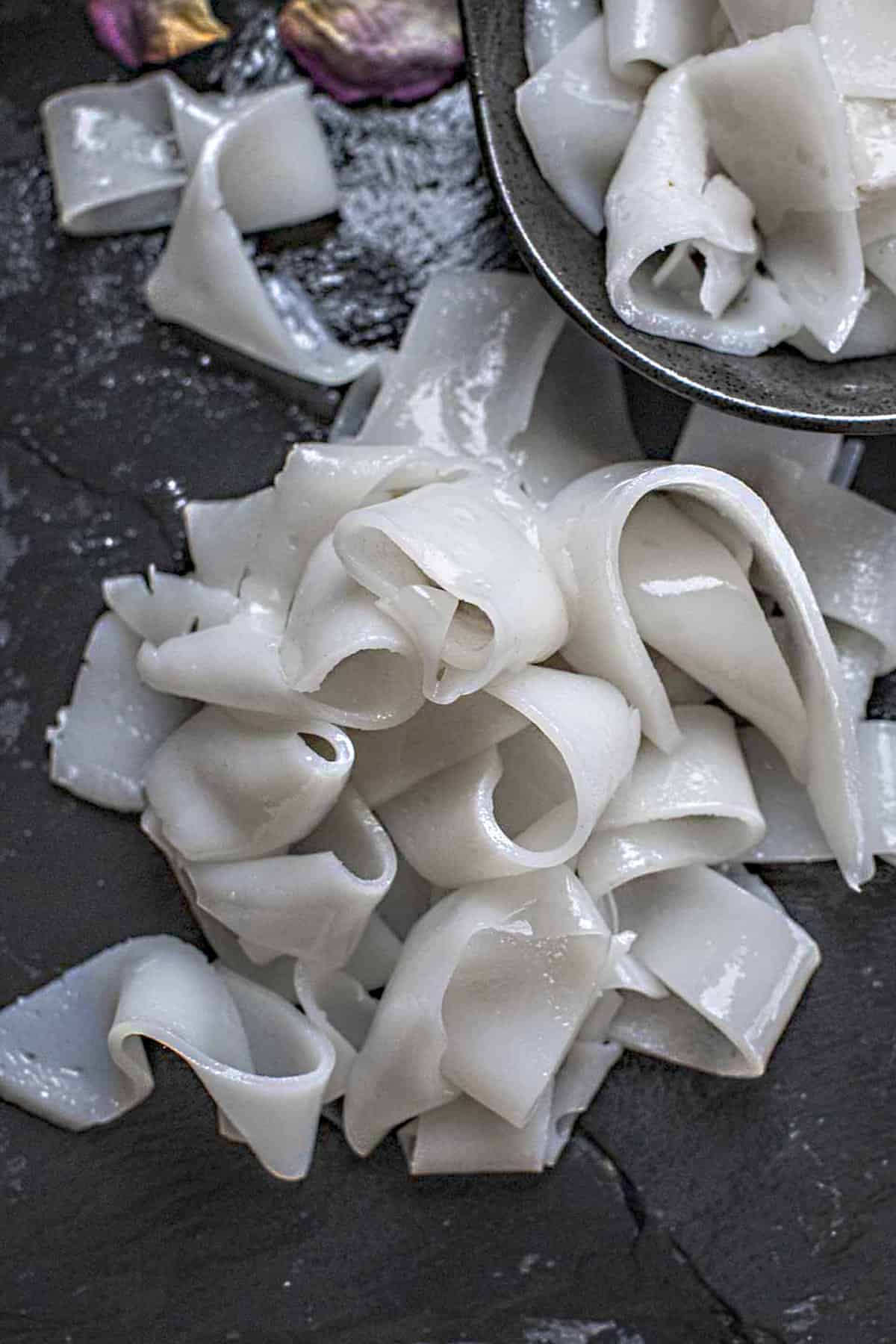
Why make your own flat rice noodles? You’ll never have to depend on your rice noodles so much anymore! You can whip up your own in a flash.
Especially for recipes like Yen Ta Fo, a Thai pink soup, Kuay Teow Kua Gai, Pad See Ew, Rad Na, and even drunken noodles.
Check out this awesome guide about Thai rice noodles! It's packed with all the information you need to understand the various types of Thai noodles.
Plus, there are pictures to help you choose the perfect noodles when you go shopping at Asian markets for your next Thai cooking adventure.
Trust me, it's super helpful.
Jump to:
- What is Sen Yai?
- Why Make Your Own Yen Yai?
- Ingredients for Making Wide Noodles
- The Right Jasmine Flour
- A Steamer Set for Making Homemade Keow Teow
- How to Make Rice Noodles from Rice Flour
- How to Use Your Fresh Gouy Teow Noodles
- How are fresh flat wide rice noodles used in Thai cooking?
- Helpful Kitchen Notes and Tips
- Helpful Kitchen Tools
- Sen Yai Noodles Substitutes and Variations
- Storage
- Top Tip
- Fresh Noodles vs Dried rice noodles
- Rice Noodles, Egg Noodles, and Pasta: What's the Difference?
- The different Types of noodles used in Thai recipes
- Helpful Kitchen Resources for your Thai cooking tips
- Frequently Asked Questions
- More Thai Noodle recipes you'll love
- How to Make Sen Yai Noodles (Thai Wide Rice Noodles)
- Related Thai Recipes
What is Sen Yai?
Sen Yai is a popular kind of noodle in Thai cuisine. In Thai, "Sen Yai" means "large stringy noodles," which refers to wide, flat rice noodles commonly used in Thai noodle dishes.
There are many names for these glorious rice noodles. Many different names in different cuisines call them. They are called Hor Fun (or ho fun or he fen) in China.
Another Thai word for these noodles is Kway Teow or Kuaitiao. Also, in Malaysia, they are called Koay Teow noodles, which is similar to the Thai pronunciation.
There are also various sizes of Sen Yai noodles. They are typically noodles with flat and wider widths.
These noodles are essential in dishes like Guay View, Ho Fun (Chinese dishes), Pad See Ew, Kuay Teow Kua Gai, and Rad Na. You can find Sen Yai noodles served in restaurants and on the streets of Thailand, where they are stir-fried to create delicious and flavorful Thai noodle dishes.
Why Make Your Own Yen Yai?
- You are in control of your ingredients! That means it's going to be fresh and chemical-free! So it's a lot healthier than store-bought noodles.
- You can customize the size and even the shape of your noodles with homemade noodles! Make the strands long and thick, or create a fun recipe shape!
- It's way easier than you think! I used to be intimidated by the mere thought of making my noodles. But after trying it a few times, it is much easier than anticipated.
- The ingredient list is small! So that adds to the easy part of making homemade noodles!
- The cooking process is not complicated. You need a few simple steps and some tips (which I share below!), and you are on your way to enjoying tasty, fresh, wide rice noodles!
- Making your own noodles is one of the most satisfying feelings ever. It gives you a strong sense of accomplishment and a great understanding of how ingredients combine to make something yummy!
Ingredients for Making Wide Noodles

- Rice Flour. Use Thai rice flour from the Asian market.
- Tapioca Flour.Also called tapioca starch. The glue that holds it all together. If not enough, your noodles will be too thin and break. Too much, and your noodles will have an unwanted starchy taste.
- Water. Use warm water. Lukewarm, not hot. Cold water will cause the noodles to lump together.
- Salt. Just a dash to avoid interference with the recipes using the noodles.
- Oil. For greasing. Use neutral oil like canola or vegetable oil.
The Right Jasmine Flour

The type of rice flour used is important. Make sure it's Thai Jasmine rice flour, not Glutinous rice flour (green letters). Look for the small 1-pound bag with red lettering.
For best results, use only Thai brand rice flour, not the brands from your regular grocery stores.
A Steamer Set for Making Homemade Keow Teow
Use a large soup pot with a metal wrack can go in to lift the pans from the bottom of the pot. I used my 6-quart stock pot, Instant Pot trivet rack, and 2 metal cake pans to go inside.
Please see the image reference below.
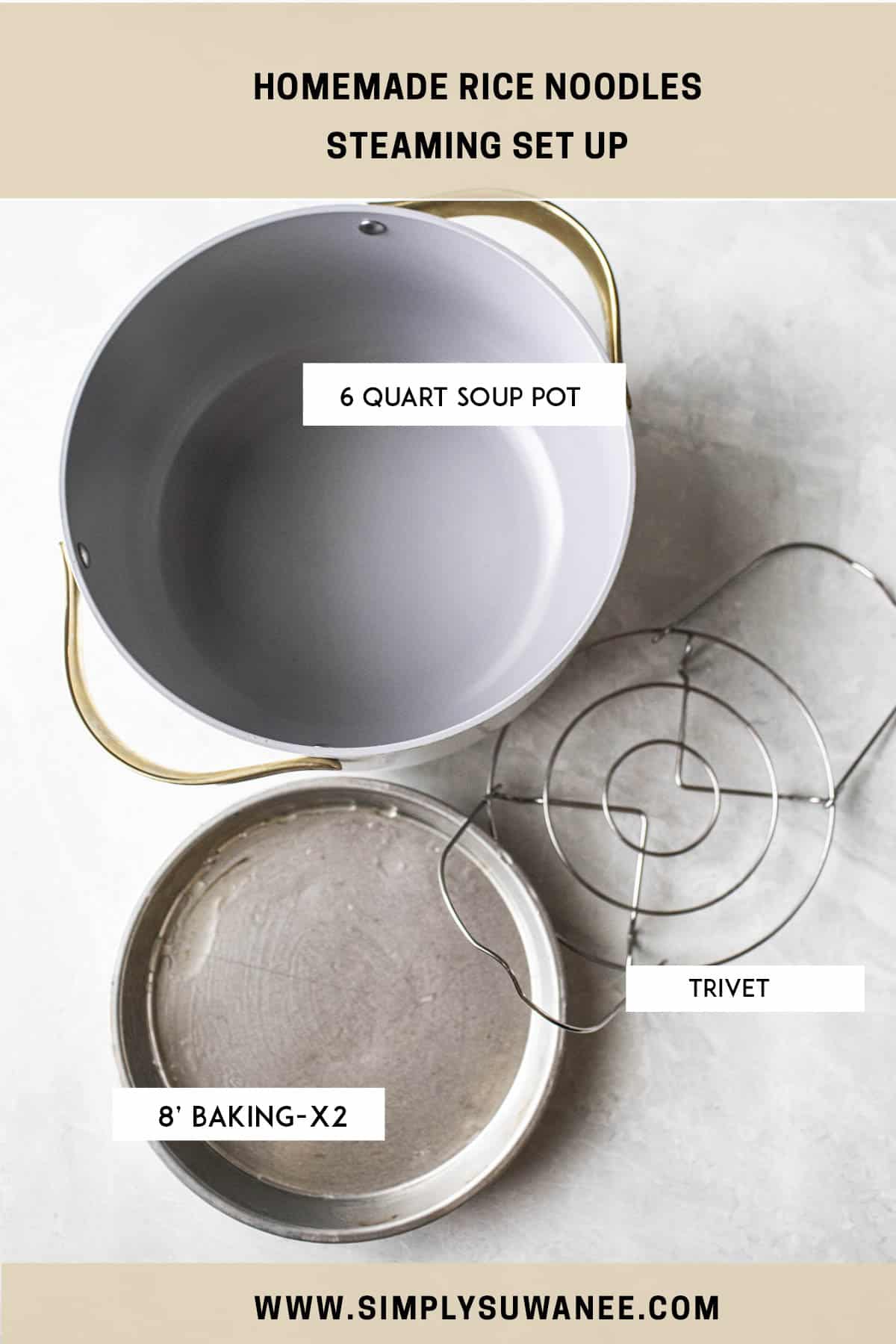
I know a lot of Asian households have huge metal steamers. They are too big for storage, and making my own makeshift steamers seems to work well. I don't mind the extra step of setting up a makeshift steamer.
It saves me a lot of pantry space!
You can also use a wok or a deep pan, but you will need a flat rack to elevate the steaming pan from direct contact with the bottom pan where water is used for steaming.
How to Make Rice Noodles from Rice Flour
1. Set up your steaming pot with the trivet in the bottom for the pan to sit on. Add water and heat on medium-high heat, and wait until the water boils.
While waiting, let's get the batter ready.

2. Combine rice flour, tapioca flour, warm water, and a dash of salt in a medium mixing bowl. Slowly pour the warm water into the flour mixture and whisk to avoid lumps.
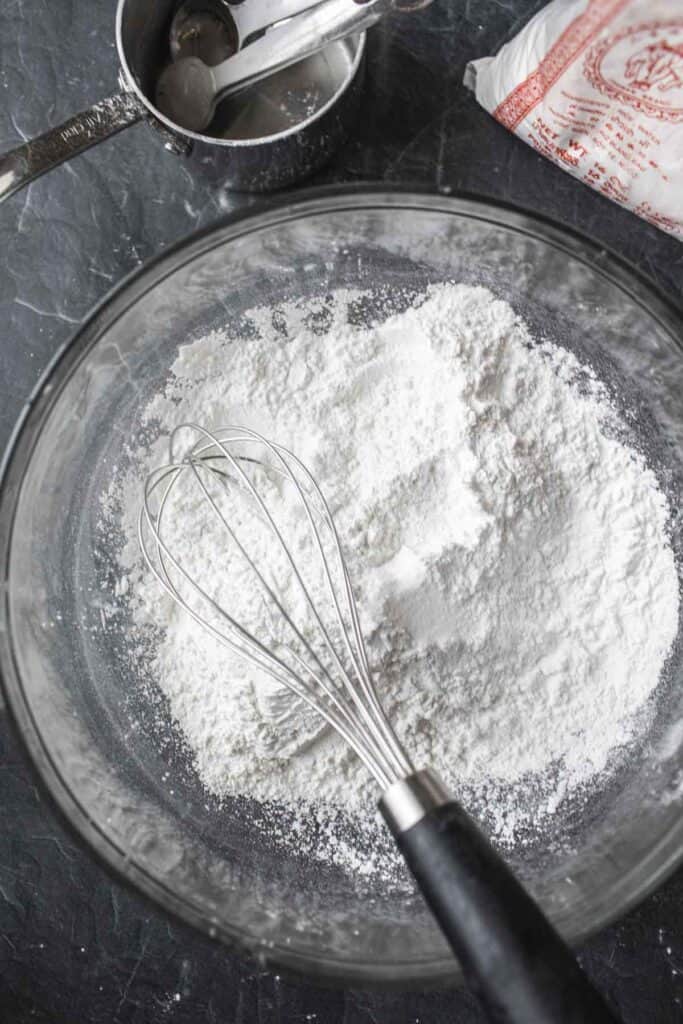


Mix until you have a creamy milky mixture that looks much like milk and has the consistency of milk.
3. Grease the bottom and side of your baking pans well with oil and a cooking brush. Use a non-stick pan with a completely flat bottom. I find pans with decals or brand logos embedded in the bottom of the pan difficult to work with.
The edging can sometimes tear the noodle sheets. You want smooth-bottomed pans.
4. Before scooping the batter into the greased pan, ALWAYS do a quick whisk or stir to wake up the flour that's been settled to the bottom to make sure you have a smooth and consistent batter. Scoop a small amount into your pan.
I used about ¼ cup for my pans. Gently roll the batter around to have all the surfaces covered. You might have some patchy spots, but it's ok. Try lightly moving the batter around if the pan is not too hot.

5. Place the pan with the batter in the steamer. Make sure the bottom is flat or you will get uneven-sized and partially over and undercooked noodles.
Steam the batter until it forms a thin, milky sheet.
Mine took almost exactly 2.5 minutes for each batch. Cover with lid and wait. Setting a timer helps so much!

6. Once your timer goes off, carefully remove the hot pans from the steamer, place them on a heat-safe surface, and wait for them to cool off a little.

7. Grease the second pan, repeat steps #3-5, and keep going until your batter is gone.
8. While the 2nd pan is steaming, remove your cooked noodles from the 1st pan. Have a cutting board, platter, or counter space ready to place your noodles flat for cutting. Rub a thin layer of oil on those surfaces to prevent the noodles from sticking.
* save all your ripped sheets (Image below), and don't throw them! They are still usable. Save them for stir-frying, or spread chili oil and enjoy them fresh!

9. Before peeling off the noodles sheets from the pan, brush a light oil coating on top of the cooked noodles still in the pan to help remove the sheets.
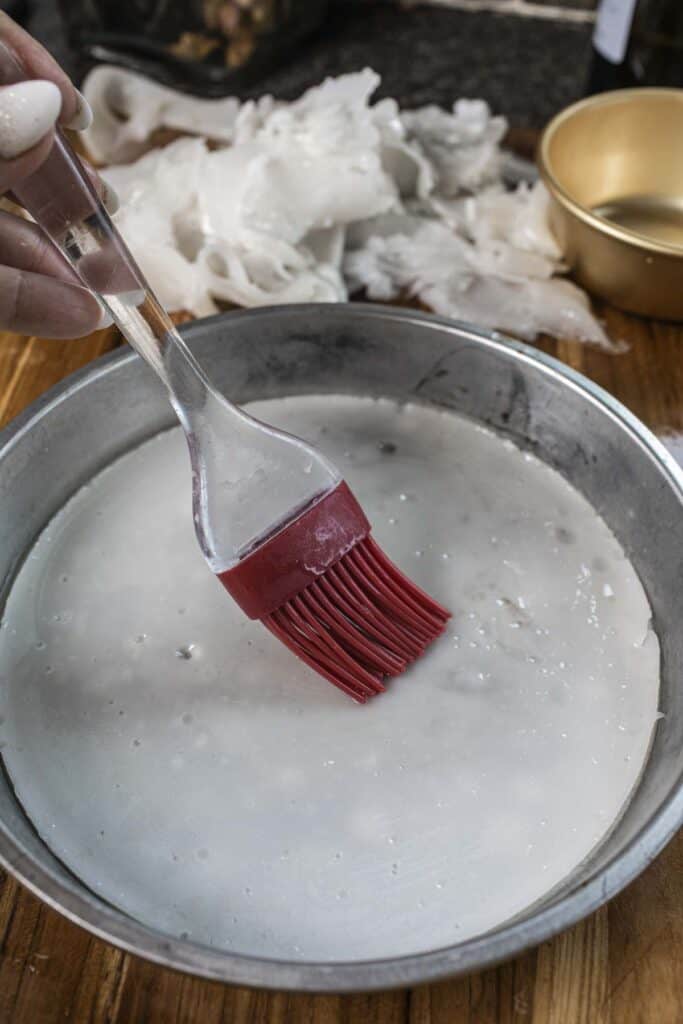
9. Then, use a small spatula (dip the edge with a little oil if you'd like) and sweep it around the entire outer edge of the pan to loosen up the sheet.
Then, carefully lift the sides of the sheet of noodles from the pan until it comes off fully.

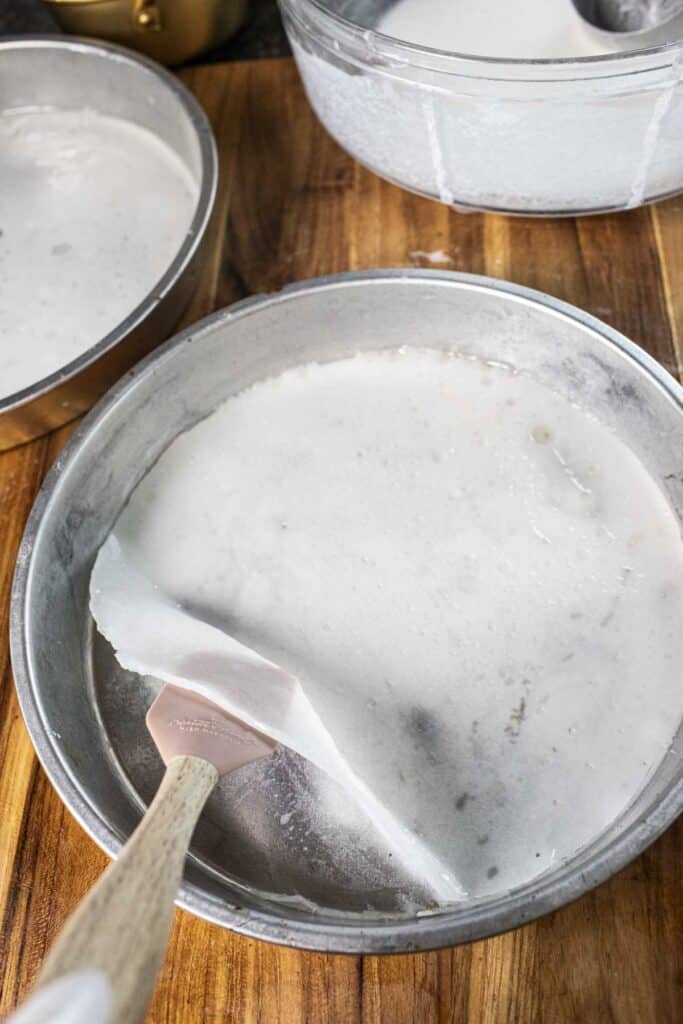

Place it on a greased cutting board or cooking surface.
10. Cut the noodles into any size you prefer! That's it! You did it! Your homemade fresh flat noodles are ready for your recipes. See below for ideas for rice noodle recipes.
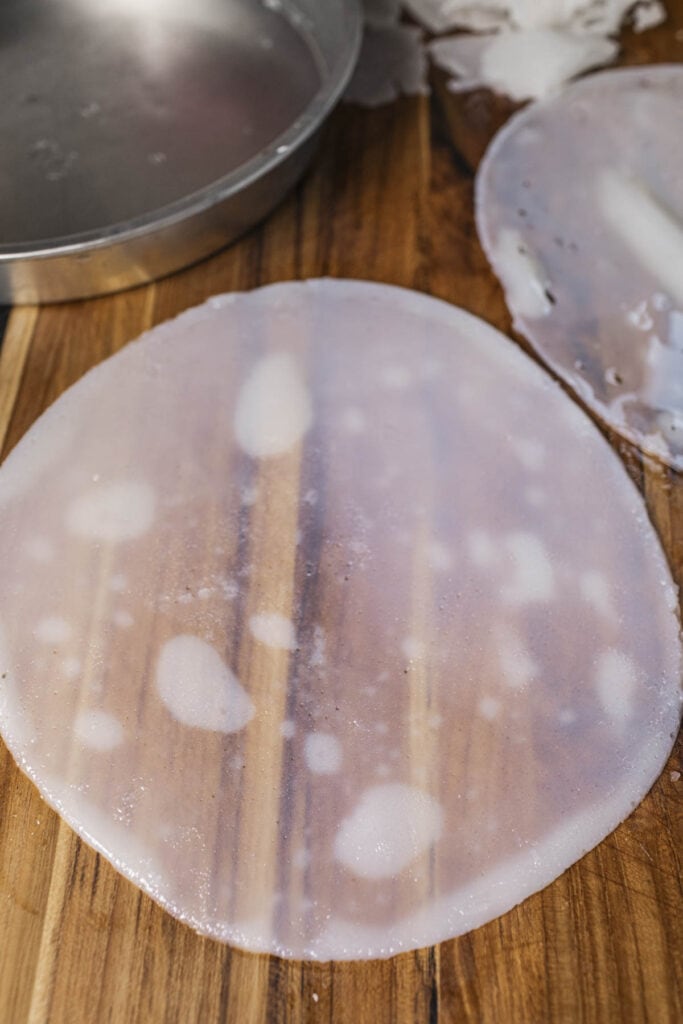

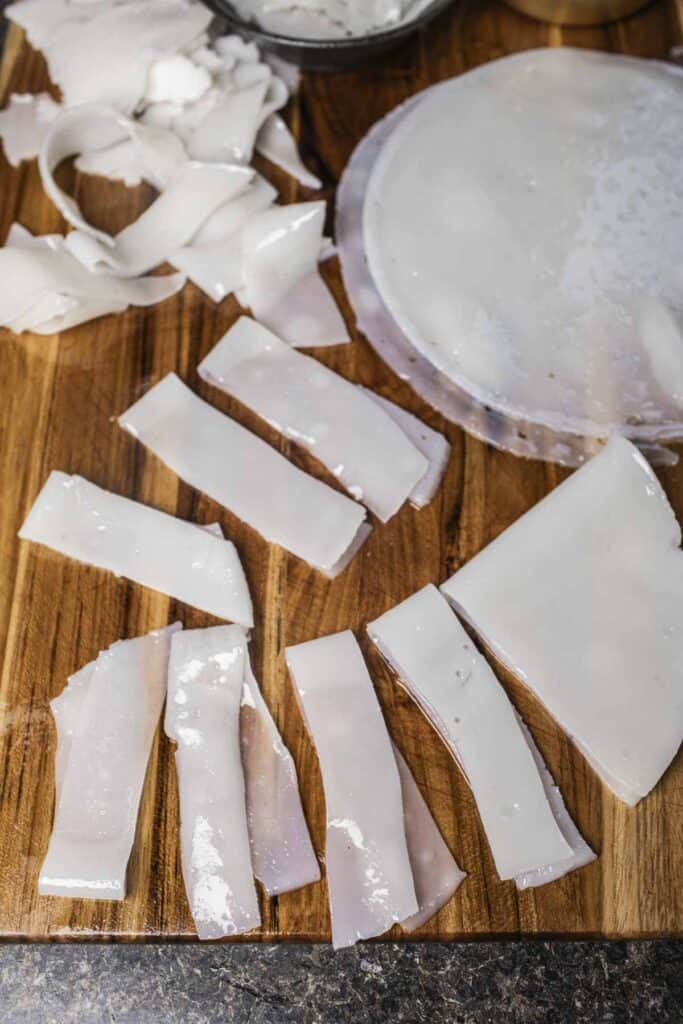
That's it! Happy Cooking!
How to Use Your Fresh Gouy Teow Noodles
- Radna or Lad Na.Thai rice noodle dish using flat rice noodle sheets, Chinese broccoli (Gai Lan), and savory gravy sauce.
- Pad See Ew. Pad See Ew is a stir fry noodles recipe that is a popular noodle dish made with wide fresh rice noodles and a savory and slightly salty sauce made with black soy sauce, fish sauce, and protein of choice.
- Kua Gai Guay Teow. It is also made with wide rice noodles stir-fried with chicken marinated in oyster sauce, soy sauce marinated with eggs, and chili pepper flakes. Stay tuned for a recipe using these homemade rice noodles!
- Pad Kee Mao stir-fries. The type of noodles used for Pad Kee Mao differs from chef to chef. I've seen recipes with Sen Yai rick sticks, the ones larger than the Pad Thai Noodles to pho noodles. My personal favorites are these Geuy Teow soft noodles. Fresh ones are game-changers!
How are fresh flat wide rice noodles used in Thai cooking?
Fresh flat wide rice noodles are a staple in Thai cooking, particularly in popular noodle dishes found in Thai restaurants and sold by street vendors.
These noodles are stir-fried in carbon steel over high heat to achieve a delicious smoky flavor known as "Wok Hei."
Two classic Thai dishes that features these noodles are Pad See Ew and Kuay Teow Kua Gai which combines fresh, flat, wide rice noodles with a savory sauce made from fish sauce, dark soy sauce, and dark, sweet soy sauce.
Another mouthwatering option is Kua Gai with chicken, where the noodles are stir-fried with flavorful ingredients like light soy sauce and Thai soy sauce.
So the next time you're craving Thai stir-fried noodles, look no further than these fresh flat wide rice noodles. Their ability to absorb flavors and perfectly chewy texture will elevate your Thai noodle dishes to new heights of deliciousness.
Helpful Kitchen Notes and Tips
- Use only Thai brand jasmine e rice flour from the Asian market. (In red lettering). Rice flour from regular grocery stores will give you very different results since the texture of the flour is not the same. Rice flour is this recipe's base and main component, so use the right ingredients. See the ingredient shot above for reference.
- Use warm, not hot, water to add to the flour mixture. It helps with blending the flour ingredients into a smooth consistency.
- Always stir the batter before adding to the steaming pan to ensure all the flour mixture at the bottom has been waking up.
- Find the right balance between rice and tapioca flour for the perfect rice noodles. Adjust to your liking for that ideal consistency.
- Grease the pan well for easy peeling and prevent tearing. But do not overdo it, or the oil droplets will create bubbles in the cooking process and turn your cooked noodle sheet into gappy wholes.
Helpful Kitchen Tools
- 8-inch round baking pans
- 6 quarts Dutch oven to use as steamer
- Steamer
- Instant pot 6-quart Trivet or a set of steamer racks with long and short handles.
- Brush for oil
- Rubber spatula
Sen Yai Noodles Substitutes and Variations
Looking for substitutes for flat rice noodles? Don't worry. I've got you covered! Here are a few options that you can use in your recipes:
- Chinese Wide Knife-cut noodles or Dao Xao Mian. These are wide, long, wavy noodles made from regular all-purpose flour and water. They are thick and supple, making them a perfect replacement for larger noodles.
- La mien or Pulled Noodles. These thick noodles, made from wheat flour, have a firm and consistent texture. They work great as a substitute for Gouy Teow.
- Chow fun or He Fen noodles. Used in Cantonese cuisine, these noodles have the same width and length as Thai dried wide noodles used in Pad Kee Mao. You can find them in East Asian markets, either refrigerated or dried.
- Bánh Cuốn Flour. This Vietnamese rice flour is typically used for making Rice rolls. You can find it as a flour mix in a packet, which you can easily mix and make at home. Some well-stocked grocery stores may also have fresh options in the refrigerator section.
So, the next time you're in need of a substitute for flat rice noodles, give these alternatives a try!
Storage
Store your cooked rice noodles in an airtight container and use it within 24 hours. It is best to use it immediately, but waiting a few hours is fine. More than that, your noodles will turn into mushy noodles.
Top Tip
- Skip the oil in the batter! Adding oil to the flour mixture can cause some problems. Since oil does not mix with water, so when you add it to the pan, it creates bubbles in the batter. These bubbles won't cook evenly and can result in tears and holes in your noodle sheets.
- So, leaving the extra oil out of the batter and enjoying smooth and perfect noodles is best! (Do use it for greasing the pan and after the noodles are cooked!)
- Greasing your pans with oil will have enough grease to separate the sheets from the pan. Adding any amount to the mixture before cooking is too much. It's pretty frustrating when your sheets don't turn out.
Fresh Noodles vs Dried rice noodles
There are differences between fresh and dried noodles. Oftentimes, I see this is the part where many people stumble when making rice noodles recipes. They often end up preparing the noodles incorrectly and have mushy noodles that don't taste right for recipes.
It's confusing, I know. Here's what you need to know about noodles.
Fresh rice noodles are softer and more al dente than dried rice noodles. They come in vacuum-sealed packages and need to be refrigerated. Before using them, follow the packaging instructions for pre-cooking preparation.
On the other hand, dried rice noodles can be found on grocery shelves at room temperature. These noodles take longer to soften and hydrate before using them in recipes.
If it's your first time using dry rice noodles, read the package instructions, as the preparation method may vary depending on the brand and size of the noodles.
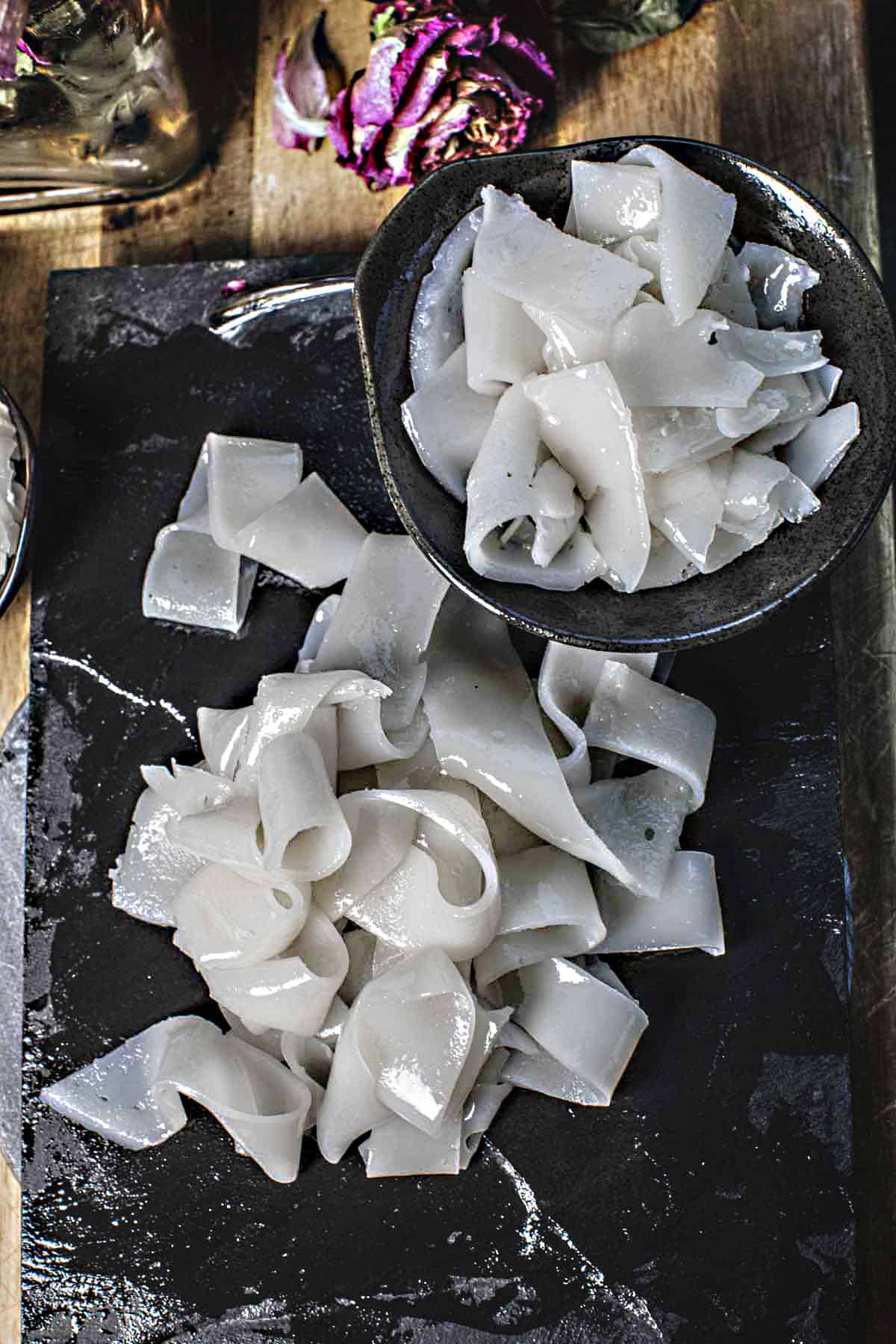
Rice Noodles, Egg Noodles, and Pasta: What's the Difference?
Rice noodles, egg noodles, and pasta are three different types of noodles that you can enjoy in various dishes. All three of these noodles are found and used in Thai cooking. Yes, even pasta!
They are becoming increasingly popular in Thailand, especially in big cities and upscale restaurants. They are used more as a fusion ingredient to mix with Thai flavors and seasonings.
Rice noodles are made from rice flour and are commonly used in Asian cuisine, such as in dishes like Pad Thai or Pho. They are delicate, slightly chewy, and often served in soups or stir-fried dishes.
As the name suggests, egg noodles are made with eggs and flour. They are rich and slightly yellow and are commonly used in dishes like chow mein or lo mein. Egg noodles have a soft and smooth texture and absorb sauces and flavors well.
Pasta, on the other hand, is made from durum wheat flour and water. It is a staple in Italian cuisine and comes in various shapes like spaghetti, penne, or lasagna.
Pasta has a firm and chewy texture and pairs well with various sauces, from creamy Alfredo to tangy marinara.
Each type of noodle offers a unique taste and texture, so it ultimately depends on your personal preference and the dish you are making. So, go ahead and try all three to find your favorite!
The different Types of noodles used in Thai recipes
Read here for a comprehensive guide on Thai noodles.

- Sen Lek. Sen mee, a thin rice noodles. They are the very thin, angel hair-like rice vermicelli.
- Sen Yai. Wide rice stick noodles are often used in noodles and stir-fries dishes.
- Pad Thai noodles. These are often called rice sticks, thin fresh rice noodles, the same noodles used in Pho noodle soups.
- Kuay Teow. These flat, wide rice noodles are silky soft and perfect for stir-fries, soups, or as a plain dish with chili oil.
- Egg noodles. Baa Mee, these yellow noodles look like lo mein or chow mein noodles. They are often used in stir-fries and soups.
- Glass noodles or Woonsen. These silvery noodles are made from mung bean or sweet potato starch. They are excellent in salads like Yum Woon Sen and Goong Op Woon Sen and Shrimp salad with glass noodles.
Helpful Kitchen Resources for your Thai cooking tips
- Essential sauces in Thai cooking. Learn the different types of sauces in Thai cooking.
- Different types of rice in Thai cooking
- Different types of Thai noodles in Thai recipes
- Herbs and spices in Thai cooking
- Thai pantry essentials
- Thai kitchen tools
Frequently Asked Questions
Sen yai noodles are typically wide and can be from ½ inch to 3 to 6 inches of wide flat sheets.
Rice noodles are called "sen." which means string or stringy things like noodles.
Sen Yai noodles can be easily found at most Asian grocery stores.
Rice noodles can be a healthy choice, especially when homemade, allowing control over ingredients. Check the recipe card below for complete nutritional information on this recipe.
Various online calculators also help you determine the macro and micronutrients of different types of rice noodles used.
More Thai Noodle recipes you'll love
- Pad Thai is a famous stir-fried noodle with sweet, savory sauce, rice noodles, herbs, and crunchy bean sprouts for garnish.
- Pad Mee Korat. A lesser-known rice noodles stir fry with more ingredients, mainly sauces and spices, to heighten the flavors.
- Pad Mee is a simple rice vermicelli noodle with minimal ingredients but full of flavors!
- Beef Pad Thai is an easier cheat version for those who can not and do not have Asian grocery stores to grab all the authentic Asian ingredients.
- Pad Woonsen. A glass noodle stir fry with vegetables and savory umami sauce.
- Gaeng Jeud Woonsen. A clear glass noodle soup with soft silken tofu and a rich herbaceous Thai broth.
**Love a recipe you've tried? Please leave a 5-star rating in the recipe card below and a review in the comments section further down the page. Or follow me on Facebook, Pinterest, or Instagram!**
Print
How to Make Sen Yai Noodles (Thai Wide Rice Noodles)
- Total Time: 25 minutes
- Yield: 1.2-1.5 pounds of noodles 1x
- Diet: Gluten Free
Description
Learn how to make Sen Yai Noodles (Thai wide rice noodles) at home with simple ingredients and easy steps to elevate your noodle game! Enjoy your fresh noodles in soups and stir-fries at a whole new level you won't forget!
Ingredients
- 1 cup jasmine rice flour, a Thai brand.
- ½ cup tapioca flour
- 1 ½ cup water
- ¼ teaspoon salt
- Oil for brushing. As needed.
Instructions
-
Set up your steaming pot with the trivet in the bottom for the pan to sit on. Add water and heat on medium-high heat, and wait until the water boils. While waiting, let's get the batter ready.
-
Combine rice flour, tapioca flour, warm water, and a dash of salt in a medium mixing bowl. Slowly pour the warm water into the flour mixture and whisk to avoid lumps. Mix until you have a creamy milky mixture that looks much like milk and has the consistency of milk.
-
Grease the bottom and side of your baking pans well with oil and a cooking brush. Use a non-stick pan with a completely flat bottom. I find pans with decals or brand logos embedded in the bottom of the pan difficult to work with. The edging can sometimes tear the noodle sheets. You want smooth-bottomed pans.
-
Before scooping the batter into the greased pan, ALWAYS do a quick whisk or stir to wake up the flour that's been settled to the bottom to make sure you have a smooth and consistent batter. Scoop a small amount into your pan. I used about ¼ cup for my pans. Gently roll the batter around to have all the surfaces covered. You might have some patchy spots, but it's ok. Try lightly moving the batter around if the pan is not too hot.
-
Place the pan with the batter in the steamer. Make sure the bottom is flat or you will get uneven-sized and partially over and undercooked noodles. Steam the batter until it forms a thin, milky sheet. Mine took almost exactly 2.5 minutes for each batch. Cover with lid and wait. Setting a timer helps so much!
-
Once your timer goes off, carefully remove the hot pans from the steamer, place them on a heat-safe surface, and wait for them to cool off a little.
-
Grease the second pan, repeat steps #3-5, and keep going until your batter is gone.
-
While the 2nd pan is steaming, remove your cooked noodles from the 1st pan. Have a cutting board, platter, or counter space ready to place your noodles flat for cutting. Rub a thin layer of oil on those surfaces to prevent the noodles from sticking. * save all your ripped sheets (Image below), and don't throw them! They are still usable. Save them for stir-frying, or spread chili oil and enjoy them fresh!
-
Before peeling off the noodles sheets from the pan, brush a light oil coating on top of the cooked noodles still in the pan to help remove the sheets. Then, use a small spatula (dip the edge with a little oil if you'd like) and sweep it around the entire outer edge of the pan to loosen up the sheet. Then, carefully lift the sides of the sheet of noodles from the pan until it comes off fully. Place it on a greased cutting board or cooking surface.
-
Cut the noodles into any size you prefer! That's it! You did it! Your homemade fresh flat noodles are ready for your recipes. See below for ideas for rice noodle recipes. That's it!
Notes
- Use only Thai brand jasmine e rice flour from the Asian market. (In red lettering). Rice flour from regular grocery stores will give you very different results since the texture of the flour is not the same. Rice flour is this recipe's base and main component, so use the right ingredients. See the ingredient shot above for reference.
- Use warm, not hot, water to add to the flour mixture. It helps with blending the flour ingredients into a smooth consistency.
- Always stir the batter before adding to the steaming pan to ensure all the flour mixture at the bottom has been waking up.
- Find the right balance between rice and tapioca flour for the perfect rice noodles. Adjust to your liking for that ideal consistency.
- Skip the oil in the batter! Adding oil to the flour mixture can cause some problems. Since oil does not mix with water, so when you add it to the pan, it creates bubbles in the batter. These bubbles won't cook evenly and can result in tears and holes in your noodle sheets. So, it is best to leave the extra oil out of the batter and enjoy smooth and perfect noodles! (Do use it for greasing the pan and after the noodles are cooked!
- Greasing your pans with oil will have enough grease to separate the sheets from the pan. Adding any amount to the mixture before cooking is too much. It's pretty frustrating when your sheets don't turn out.
- Prep Time: 5 minutes
- Cook Time: 25 minutes
- Category: Noodles
- Method: steaming
- Cuisine: Thai
** Thank you so much for visiting my blog! This is truly a passion for me. If you have enjoyed these recipes and appreciate the hard work I put into them, I would love it if you would share them with your friends! Your recommendation is the highest review I could hope for, and I’d appreciate it! **
Related Thai Recipes
Looking for other recipes like this? Try these:


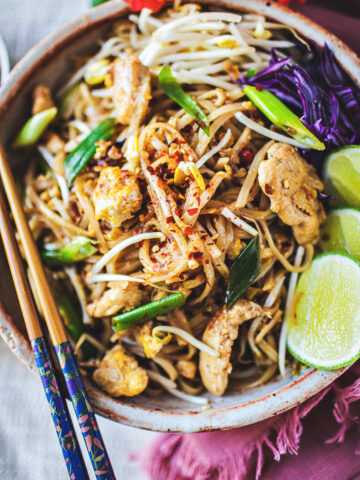
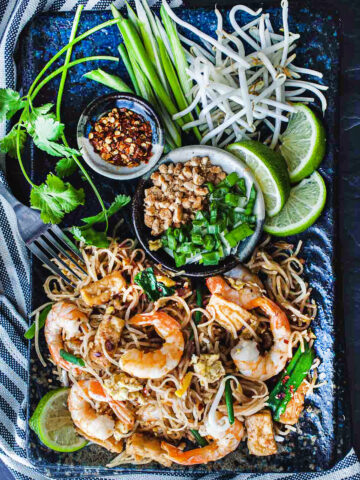


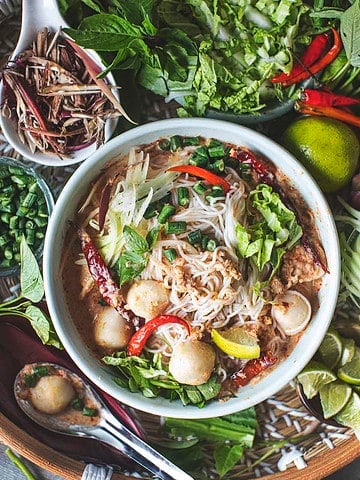


Suwanee
You're welcome! So glad you liked it!
Rollene
Thank you for all the information with the recipe.
C
Wow! A whole world of homemade noodles opens up with this recipe! I had never seen the process for fresh rice noodles. Can't wait to try these.
CassieT
YES!! Our favorite noodles EVER!! Thank you!!
Mark
Fresh noodles make all the difference. Homemade noodles even more so! I could eat them all day every day!